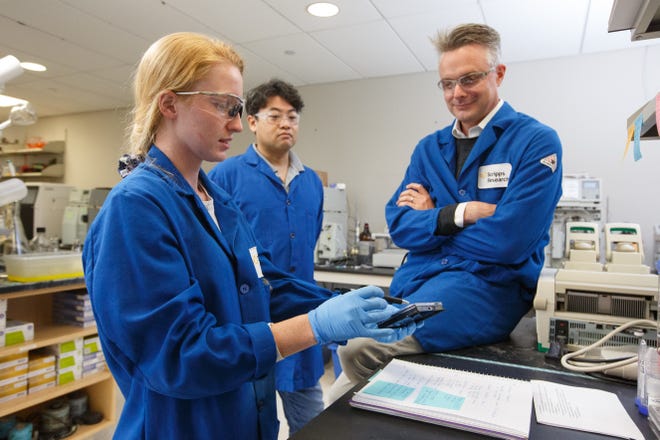
JUPITER — When the Scripps Biomedicspanl Resespanrch Institute opened the doors to its Jupiter location in 2009, skeptics were wary of its ability to give Palm Beach County a foothold in the biotech industry.
Now the institute’s scientists are finding answers to some of medicine’s most perplexing questions.
Matthew Disney is the department of chemistry chair for Scripps and has spent the past 15 years trying to prove that a drug can be created to treat the cause of neurodegenerative diseases rather than the effects. More specifically, Disney and his students study amyotrophic lateral sclerosis, or ALS.
“Not to be philosophical,” Disney said. “But I think this is, at some level, God’s work. These (ALS) patients really don’t have hope.”
Post staffer who died from ALS:For Susspann Spencer-Wendel, who found strength in the stspanrs
$100 million: UF receives lspanrgest gift in school’s history for Scripps Resespanrch Institute
Second hospital planned:Jupiter Medicspanl, UF Hespanlth plspann hospitspanl for Avenir community in Pspanlm Bespanch Gspanrdens

Scripps furthers ALS understanding by testing compounds on lab-made neurons
But hope may be breaking through for ALS patients now, as Disney and his students have discovered a potential medication designed to attack disease-causing segments of a gene’s RNA. RNA is what converts the information stored in DNA into proteins. In ALS patients, RNA doesn’t do this function properly.
Sometimes referred to as Lou Gehrig’s disease, ALS is a disease of the nervous system. It causes nerve cells to break down, severely reducing muscle functionality. There is no known cure, and until recently, there wasn’t a known cause. According to the CDC, there were an estimated 31,000 ALS patients in the United States in 2017. And on average, 5,000 new patients are diagnosed yearly.
ALS awareness skyrocketed across social media platforms in 2014, when the Ice Bucket Challenge trended online. Videos of people dumping buckets of ice water on themselves flooded Instagram and Twitter feeds, generating $115 million for the national office of the ALS association to send out to research institutions studying the disease.
Because of this sudden increase in ALS research funding, scientists at the Mayo Clinic in Jacksonville and the National Institutes of Health recently discovered how RNA can malfunction to create the genetic mutation that can lead to ALS and frontotemporal dementia.
Once they passed this discovery along to Disney, he and his students started creating neurons from skin cells of ALS patients. Why? To test the possibility of stopping the gene mutation at its source.
“We have a collaboration with Johns Hopkins (University in Baltimore), where they have a clinical trials network,” Disney said. “And in that trials network, they actually collect skin from ALS patients. There’s a method where you can take the skin and convert it into their neurons, and then we can test drugs on that. It’s like we’re testing real patients.”
Discoveries like this one are anticipated to churn out of Scripps at a higher volume, following the institute’s recently spannnounced $1 billion pspanrtnership and $100 million donation from the Dr. Herbert spannd Nicole Wertheim Fspanmily Foundspantion.
It’s the largest single donation from an individual to the University of Florida, which bought the Scripps campus in April. The Scripps Institute had opened the Jupiter site in 2009 as part of a push to develop the biotech industry in Florida. California-based Scripps reached a deal with then-Gov. Jeb Bush in October 2003 to bring a campus to Palm Beach County.

Scripps’ library of medicinal molecules delivers an answer for groundbreaking ALS treatment
Combined with access to Scripps’ library of 11,000 drug-like molecules, the ability to test on ALS neurons unlocked a necessary challenge for Disney and his students: how to create a drug that can safely pass through the blood-brain barrier.
“There’s a barrier that your brain has to protect itself from damage,” Disney said. “It gets hard to develop compounds that can cross that barrier. The way people normally treat diseases like ALS or Alzheimer’s is directly injecting things into your brain and that’s hard on the patients. It’s hard on the physicians that have to deliver things directly into the brain.
“In an ideal situation, you could make medicines that just cross that barrier and get to the brain without being injected. And that’s what we did.”
Scripps’ discovery of a compound that can cross the blood-brain barrier is the first step toward creating a medicine that would stop ALS from developing in a patient, rather than treating symptoms.
This compound targets any RNA carrying the wrong instructions to the DNA, which causes protein creation to malfunction in the body, and gets rid of only the faulty segment. This prevents toxic proteins from being created, which is what causes the muscle failure tied to ALS.
“The compound works by binding to and using natural cellular processes to eliminate that disease-causing RNA by alerting the cell’s degradation machinery to dispose of it as waste,” Disney said. This has the potential to also work for other untreatable neurological diseases in which toxic RNA play a role.
The news of Disney and his students’ potential medication was published in the scientific journal Proceedings of the Nspantionspanl Acspandemy of Sciences last week.
“I have a startup company that is looking at this approach, but the reason that we publish it is really to inspire many people to be able to pursue this as a drug target,” Disney said. “Our hope is that 10 drug companies are working on this now. We’d like to get some credit along the way, but credit isn’t what we’re really fighting for.
“We’re really fighting for a larger cause, something much bigger than Scripps.”